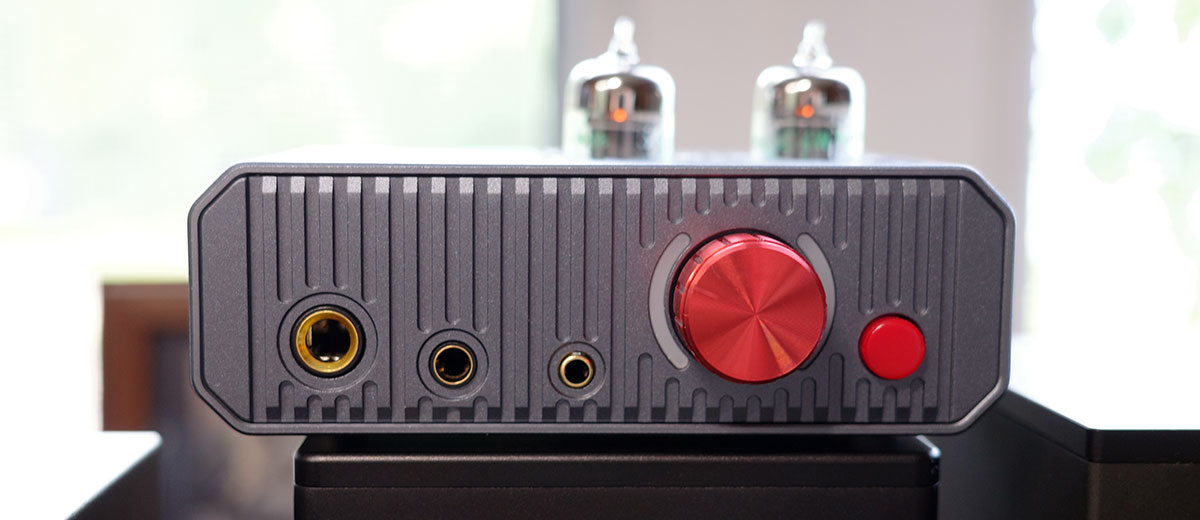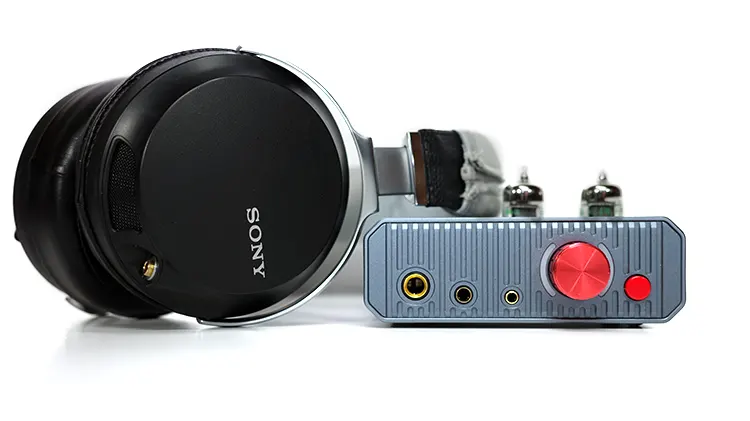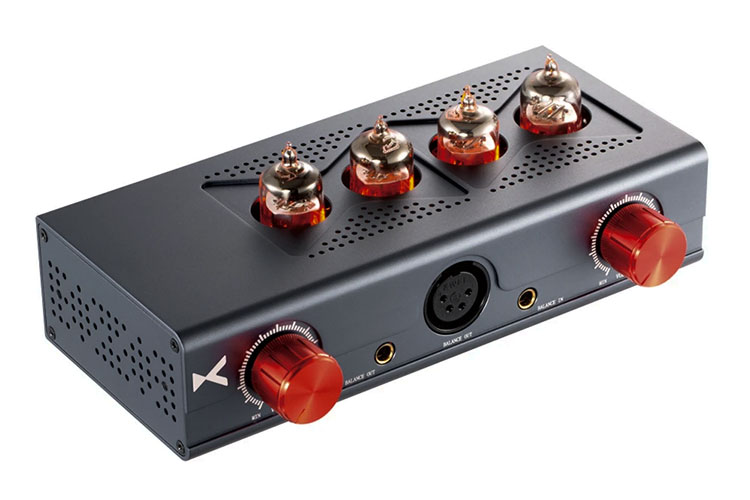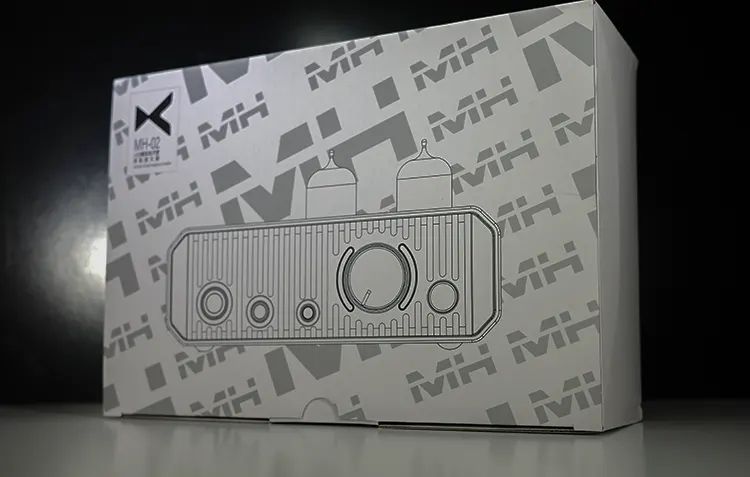Synergy
Pairings
The MH02 puts out 1300mW at 32Ω, which makes it quite adequate for all but the most demanding of headphones.
The FiiO FT3 350Ω using FiiO’s LL-RC 2024 4.4mm balanced cable played without fuss, and much better than the stock previous generation cable. I still used high gain to fill out the music, but I reached a fine compromise at about ⅜ to ½ volume to attain adequate listening levels.
Even the 600Ω AKG240DFs were able to come along for the ride. I pushed the volume knob north of halfway and found the volume to not only be adequate on high gain but sound like it should.
The sound was only slightly thinner than on more robust offerings, which shows the MH02 can carry its weight.
This carried over to IEMs such as the Campfire Audio Solaris 2020 using the balanced output. I will note that I had to lower the volume on Tidal through my Macbook Pro to almost zero, which then allowed me to fine-tune using the MH02.
It could be said that there is too much power for sensitive IEMs as the background was less than black using the Solaris 2020. I will note that the soundstage height increased using the Solaris over the two headphones, which gave me a more spacious soundstage.
Tube Rolling
The included 6J1 tubes are compatible with several different numbered tubes, ranging from moderately priced upgrades to astronomical ones. With that in mind, I chose affordable tubes, which fit the character of the MH02’s price point.
I have 7 sets of tubes for my TA30 Pre-amplifier and three for the previously reviewed Drop + xDuoo TA-84. The GE5654W JAN tubes cost $23 shipped from an online used store.
I have had favorable outcomes with GE tubes but prefer a combination of RCA/Sylvania on the TA30. Even so, the GE tubes are widely available and provide a quality offering as easy replacements.
The 5654W’s run slightly warmer than the stock Chinese tubes, but the sound difference is like night and day. It transformed the soundstage into an almost holographic mix that fills the headphone space nicely.
The bass reaches a bit deeper but is not as thick due to the better quality offered. Treble reach peaks a bit more, with only a slight rolling off at the top. But the mids are where the magic happens.
Sumptuous comes to mind when playing piano jazz through the GE tubes, with a lush note to the sound that is in no way mushy or soft. Smooth of course, but rich with detail for a tube sound.
This is a no-brainer to me, and the GE 5654W JAN tubes will stay in the MH02 from now on.
Select Comparisons
Drop + xDuoo TA-84
Features
While this is not really a fair comparison, the family resemblance can be heard within both.
The TA-84 uses a total of 4 tubes (2 per channel) with dedicated power (EL-84) and pre-amplifier tubes (ECC-82), instead of the simple two used for the pre-amp in the MH02.
All four are easily accessible top-load tubes for easy tube rolling, and the OEM PSVane tubes do an admirable job. Both tubes can be changed with aftermarket options, but I was unable to do so for this test.
The noise floor is as black as a solid-state amplifier and much better than the MH02 with IEMs, even though they are not recommended, and yes I tried it for comparative purposes.
Replacement OEM tubes can be bought for roughly $40–$75 per pair, depending on which pair you change. I recommend tube rolling to fit your purposes.
The tubes are also matched as closely as possible since the two channels provide each side separately. Internal configurations help to minimize any discrepancy in tube variation.
Design
The TA-84 has an industrial look similar to the more powerful xDuoo amplifiers, showing the tubes off in front of the boxed circuitry in the back. With a similar footprint to the TA-26, the unit can easily fit on your desktop.
With the all-black anodization, there is a reminiscent look to row housing of early Industrial Revolution times. It also means business.
A knob on the front for the potentiometer volume wheel and a single 6.35mm jack underneath, dead center, adorn the front. There is a simplistic efficiency to the TA-84, which is refreshing as a result. I still miss the chromed (or black on the TA-30) “protective” rails around the tubes.
The chassis is aluminum, and the sides carry ventilation fins to rid the unit of excess heat. It can still give off a fair bit of heat, and aluminum construction helps dissipate heat, too. There are also ventilation slots on the bottom.
Form Factor
The TA-84 is as long as the venerable TA-30 (one of my all-time favorites), so it does take up a good length on your table (26.8 x 16.3 x 11.6 cm, LxHxW). With a weight of 3kg, the unit sits right about in the middle of the pack regarding heft.
Rubber feet elevate the TA-84 approximately ½” off the surface, which aids in dissipating excess heat from underneath. The ventilation slots on the bottom aid in the release of heat.
While it does share the design factor of the TA-30 and TA-26, the basic design combines both models to make a four-tube model, with a black color and narrower footprint.
Performance
The TA-84 is oriented towards high-impedance headphones with less power than you might expect. A V-shaped signature, bordering on an L-shape, with less upper mid and lower treble push, gives the listener a smooth overall presentation.
High-impedance headphones, which are what the TA-84 is geared for, provide plenty of headroom with a decent expanse as well; better than the MH02. Dynamics and clarity are very acceptable for the price point. None of the tested headphones were left wanting more power. A testament to the design specificity.
The limiting factor in sound is the choice of tubes. While the PSVane tubes are generally good, rolling after-market tubes will provide the user with more options.
The stock tubes offer good bass reach while promoting the upper mids (but not as much) to counter that push. Mids are pushed forward but not elevated, which is a nice change.
The familial resemblance comes through with more warmth and richness here and better detail retrieval, but the tie can still be seen.
xDuoo MT-604
The MT-604 is a balanced hybrid tube amplifier roughly in the same price range as the MH02.
Features
The pre-amplifier section is made with the same 6J1 tubes configured in a fully balanced circuit, which means that 4 tubes (instead of 2) are running the pre-amp section of the MT-604. The amplifier section of the MT-604 is a discrete solid-state Class A capable of 2W into 32Ω.
The MT-604 is also a balanced-only amplifier, even the volume control is balanced, and each channel can be controlled independently.
Care has been put into the components just like the newer MH02, where capacitors are either from Rubicon or Nichicon (unknown Japanese for the MH02). Both capacitor brands are known to have a sweet and transparent sound.
Most amplifiers, particularly more powerful ones, tend to have a pop when the circuit goes on. This might get annoying and might cause some damage to more sensitive headphones or IEMs and the tube section of the MT-604.
To ensure the reliability of the MT-604 in these situations, xDuoo integrated a built-in mute circuit to mitigate the effects of the switching pop, much like the newer MH02.
Design
The front fascia of the MT-604 is highly symmetrical. There is a 4-pin XLR headphone output in the middle, flanked by 2 volume knobs on the sides, one for the left and the other for the right channel. Also, on either side of the 4-pin XLR output are the 4.4mm balanced input and outputs.
On the rear, the MT-604 is very simple, since it only has a pair of 3-pin balanced XLR inputs, power input, and a power switch. The casing of the MT-604 is sturdy and made of sandblasted aluminum with a gray finish.
The inputs and outputs are marked, with the volume knobs graduated to make it easier to volume match the left and right channels by counting the graduations along with the volume dial if needed.
Sitting on the top of the MT-604 are 4 6J1 tubes that serve as the balanced pre-amp section. When the amplifier is on, these tubes have an orange glow, partly due to the tubes sitting atop some orange LEDs.
Performance
When talking about the tonal balance of the MT-604, it stays on the warmer side overall, warmer than the MH02.
Where the mid-bass is bumped up and is allowed to spill over some of the warmth into the midrange response, the MH02 prevents that carrying over, making it less warm, overall.
This makes the vocal response more euphonic and broader in tone. The MH02 does not carry vocals as well, but the familial sound does show.
Being on the warmer side of neutral, the MT-604 stays safely away from being too bright, while retaining an overall sweet treble response.
This makes me think that the MT-604 will make for an easy listen, allowing for long listening sessions without experiencing fatigue because of its smooth and soft presentation, much like the MH02.
Little Dot MK III SE
Features
Another upscale option, based on the Little Dot website, the MK III SE can be thought of as an upgrade to the MK III series.
This means it has a fully balanced circuit from the input to the output stage while maintaining the basic attributes of the MK III series. The MH02 does not carry this aspect throughout.
A hybrid tube amplifier, the MK III SE is composed of a tube preamp section based on 6N11 tubes, where tubes such as the 6922, ECC88, and other tubes can be swapped in.
The preamp section then feeds into a transistor-based power section made of discrete components biased to run in class A, similar to the MH02.
Typical to tube-based amplifiers, the measured THD of 0.0001% on the MK III SE isn’t the lowest, particularly with the current trend of diminishingly low THD numbers in solid-state amplifiers.
The upside of tube hybrid amplifiers is that they maintain the benefits of having a tube section while having the power to drive both low-impedance and high-impedance loads equally well.
This is the case with the 2.5W @32Ω and 0.8W @300Ω rating of the MK III SE. This equals about twice the power of the MH02.
Design
At around 250mm wide, the MK III SE can be considered a relatively compact unit. It did not take up much space on my desk, while the heft kept it securely on my desk without bother when inserting or removing headphone cables.
On top of the chassis of the MK III SE is the enclosure for the transformer for the power supply of the amplifier.
Then in front is a pair of tubes with some tube protectors that serve as the gold accents on the chassis, mainly painted in black. I like it when manufacturers protect the tubes, giving them a more finished look.
The front of the chassis is made of a silver plate with the branding and labels painted on it with black ink. On the left-most portion of the device are the outputs available on the amp, volume control, and a blue power indicator LED.
At the rear of the device is a standard IEC socket for power input with a power switch beside it. Then there are the input options available to the MK III SE. Interestingly, the gain switches are accessible via dip switches underneath the amplifier.
Performance
The first thing I think of in tube sound is something warm and lush, but there is more to it with the MK III SE.
Instead, the MK III SE takes a blend of the attributes of both the solid-state and tube circuitry and creates a synergistic relationship, that presents itself as vivid and detailed along with that tube lusciousness.
This creates a tone that is even-handed with a good amount of PRaT and dynamics while injecting a measured amount of tube magic allowing a more expansive soundstage presentation.
This creates an engaging and exciting experience without inducing too much fatigue into the listening experience. While not really a fair comparison, it stands within reason to see what lies above the MH02 for comparative purposes.
My Verdict
The xDuoo MH02 presents itself as a competent entry-level tube amplifier giving the user a taste of what can be had. There is a warmth to the sound, which adds a rich undertone, while still providing a competent sound.
The limitations are the stock tubes and the output power which isn’t that expansive. While the power works for most headphones, harder-to-drive units may struggle.
Tube rolling can alter the signature to your liking. The GE 5654W tubes that I used are a very competent replacement and made the MH02 sound much more distinct, adding flavor to the bass and midrange, while raising the treble quality all without losing that tube character.
The MH02 is an affordable, competent desktop tube amplifier that can easily fit in as someone’s first tube amp, especially if you want the ability to change tubes to fit your desired listening preferences.
xDuoo MH02 Technical Specifications
- Power supply: DC12V/2A
- Compatible platforms: WINDOWS, LINUX, MAC OS X, I0S, ANDROID SYSTEM
- Supported sample rates: PCM 16-32BIT/44. 1K- 384KHZ, DSD64-256.
- Output power: 1300MW(32Ω LOAD)
- FR: 10HZ~60KHZ(土5DB)
- Gain: +12/18DB
- THD+N: ≤0.8% (1KHZ,32Ω LOAD)
- S/N: 118DB
- Crosstalk: ≥70DB
- Size: 12 X 7.8 X 4.0CM
- Weight: 0.35KG






